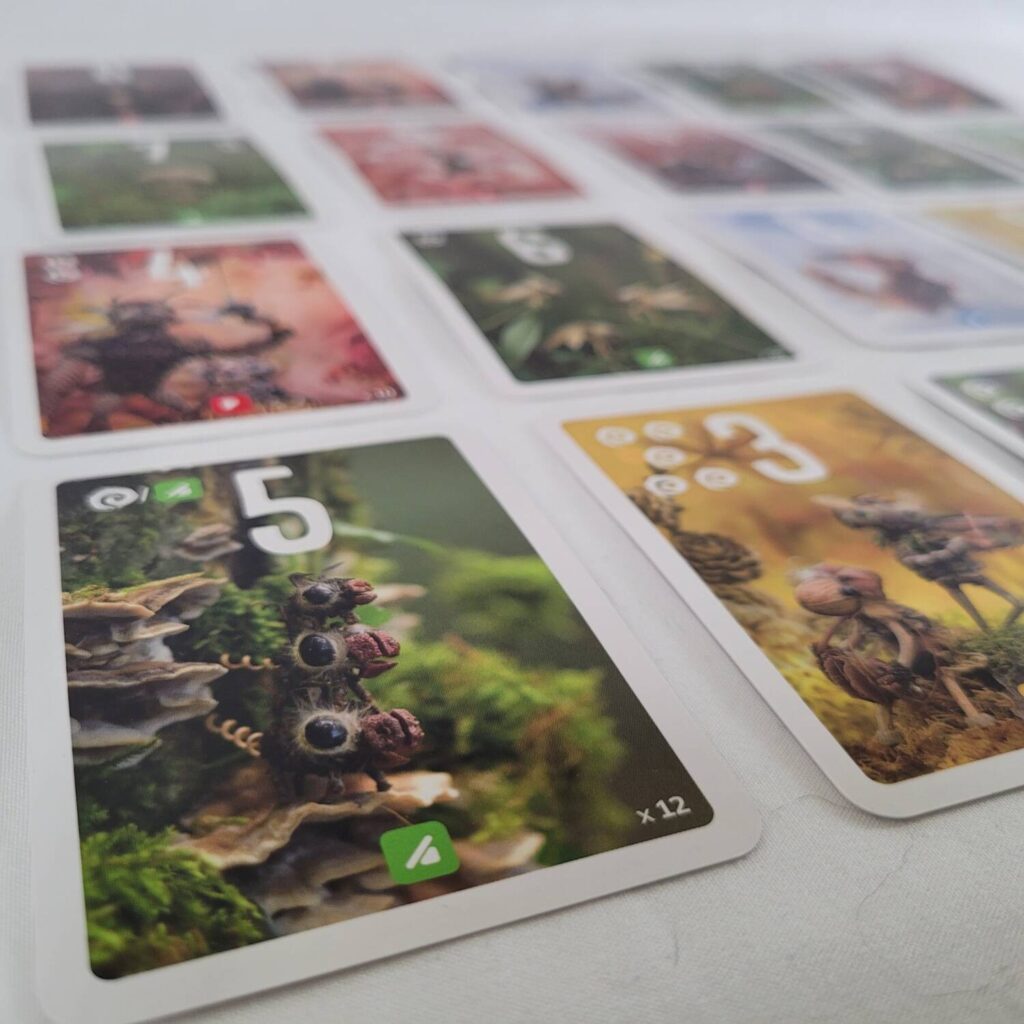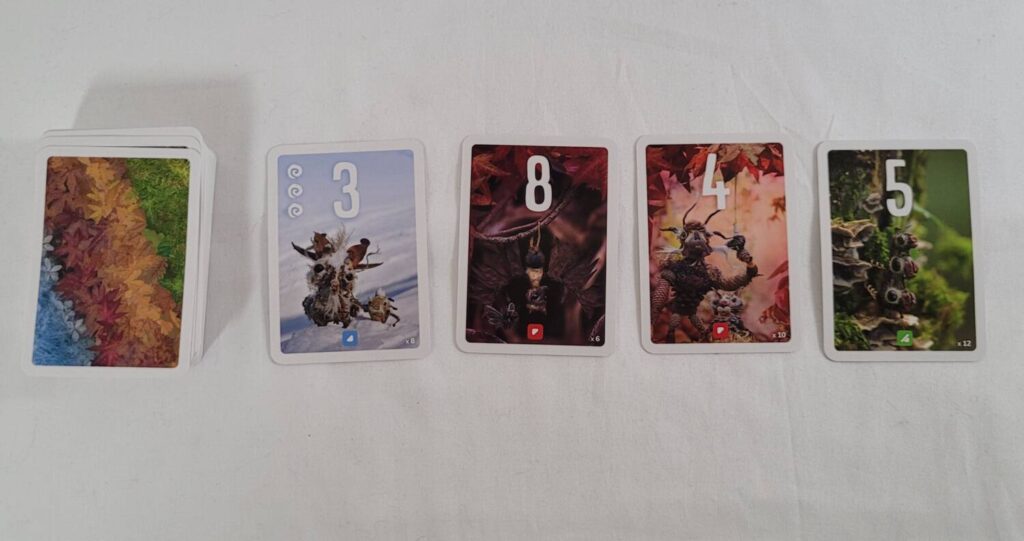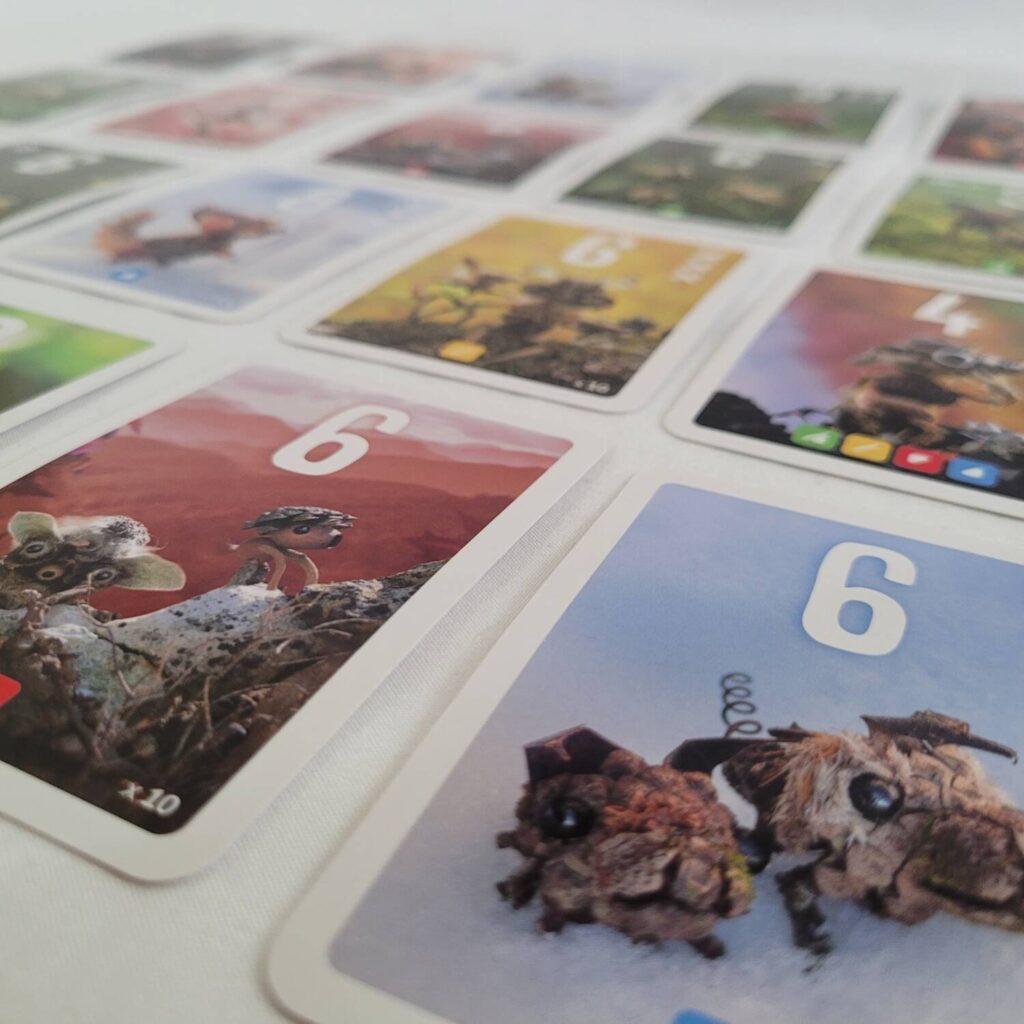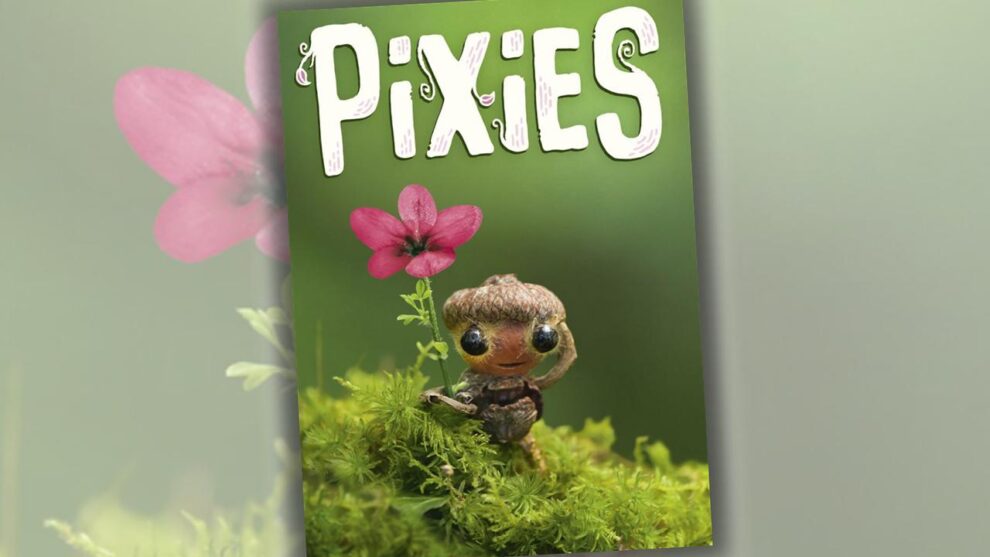Disclosure: Meeple Mountain received a free copy of this product in exchange for an honest, unbiased review. This review is not intended to be an endorsement.
Have you ever been walking through the woods, enjoying nature, when you hear a weird rustle in the leaves? Or perhaps it’s a branch in the canopy above you making a sudden noise. Or maybe it’s just a general feeling that something is there, just off the path, watching you from the underbrush. Whether its intentions are good or bad are entirely unknown. All you know is that you are not as alone as you thought you were.

If you’ve ever had this experience before, chances are you were just mere feet away from a pixie. In the game of Pixies, players take on the roles of…
Well, who knows really? The story above is something I created out of whole cloth. Aside from the delightful images of weird little creatures created out of natural objects (think Little Big Planet meets Marcel the Shell With Shoes On and you’ll have an idea of the aesthetic), there’s not a lot of theme or story to go around. At its heart, Pixies is a pure abstract. Albeit, it’s an abstract with some ridiculously cute artwork.
Overview
In Pixies, the players will take turns drafting cards out of a lineup and then placing them into their tableaus following some simple rules. Once any one player has completely filled their tableau, the round comes to an end and scoring is performed. This score is recorded and another two rounds are performed in the same fashion. At the end of the third round, the players tally up their three scores and the person who has the highest total wins.
Of course, this is a very high-level overview of the game. If you’d like to get a better sense of how the game is played, read on. Otherwise, feel free to skip ahead to the Thoughts section to see what I think of the game.
How It’s Played
At the beginning of a game round, all the cards are gathered, shuffled together, and placed into a facedown deck between the players. A number of cards equal to the player count are drawn and placed into a face-up row (except for 2-player games in which 4 cards are revealed). Beginning with the first player, players take turns drafting a card from the lineup until there are no cards left. Then, they play those cards into their tableaus.

A tableau consists of a 3×3 grid. Each spot in the grid is associated with a specific number: the top row is for numbers 1-3, the middle for numbers 4-6, and the bottom is for 7-9. When a player drafts a card, they play that card face-up into the empty spot matching the number printed on the card. Sometimes, though, there may already be a card played into that spot. In this case, the player will choose one of the two cards to place face-up and the other to place face-down beneath it. This face-up card with the one beneath it is considered to be ‘validated’.
Now, it may happen that there are already two cards in a spot when a player drafts a third card containing the same number. If this occurs, the player must place this newly acquired card face-down into another empty spot. Then, if a card is drawn that could be placed into the spot that now contains a facedown card, the player has no choice but to play the newly drafted card face-up into that spot where it automatically becomes validated.
To better explain that, consider this example. In turn one, Player A drafts a ‘2’ card. This is placed face-up into the middle slot of the top row in the #2 position. In a later turn, the same player drafts a second ‘2’ card. They opt to keep this new card as the face-up card, turn the existing card face-down, and place the new card atop it. Now, their ‘2’ card is validated. In a later turn, they draft a third ‘2’ card. Since their #2 position is already filled with a validated card, they must place the newly acquired ‘2’ card face-down into another slot. They see that the #9 position is empty and opt to place the card face-down there. Later on, they draft a ‘9’ card. Since there is already a face-down card in the #9 position, they place their newly acquired card face-up on top of it where it automatically becomes validated.
After any player has filled in their ninth spot, a scoring is performed, the score recorded, the cards gathered up and reshuffled to form a new deck, and a new round begins. After three such rounds, the scores are tallied up to determine the winner.
So, you might be wondering what goes into scoring? And, by default, what goes into choosing which cards to draft? Glad you asked.
How Scoring Works
There are a total of four scoring criteria: spirals, crosses, validated cards, and color zones.

Some cards feature a number of spirals on them or a symbol that is equal to ‘one spiral per every face-up card of a specific color in the tableau’. These score accordingly.
As an example, assume you have three yellow cards in your tableau as well as one wild card (these are considered to be all colors at all times). One of the yellow cards has 5 spirals printed on it and another yellow card has the symbol that means ‘this card is equal to one spiral for every yellow card in your tableau’. These two cards would collectively score you 9 points—5 from the spiral card and another 4 from the ‘1 spiral for every yellow card’ card (3 yellow + 1 wild card). It’s also worth noting that wild cards can be used to score multiple ‘one spiral per every face-up card of a specific color in the tableau’ cards. So, if you had a blue card that scored for every blue card with a spiral, the wild card would count for that one as well.
Some cards have crosses printed on them. These score you 1 negative point per cross. As you can imagine, you’ll typically want to avoid these.
We’ve already spoken about how cards become validated. A validated card scores points equal to its face value. So, the ‘2’ card in the earlier example would score two points and the ‘9’ card would score an additional nine for a total of eleven points between them.
A color zone consists of a string of cards of a matching color that touch each other. If the yellow cards in our previous example were located in the #1, #2, and #5 position with the wild card in the #4 position, then we would have a yellow color zone consisting of four cards. At the end of round 1, each card in your largest color zone is worth two points each. At the end of round 2, they are worth three points each. And, at the end of round 3, they are worth four points each.
Face-down cards with nothing on top of them score nothing.
Thoughts
When I first ripped open the mailer this game was sent in and stared down at the tiny little package that lay nestled inside, I wasn’t prepared for just how much I was going to like Pixies.
The box is small and unassuming, taking up less real estate than your standard cell phone. On the front cover is a little guy that appears to be created from an acorn fused together with a piece of a pinecone grinning at you with the shiny pebbles that serve as its eyes. In its arm, it holds a tiny pink flower. It’s an image that welcomes you in. Its cheery warmth brings a slight smile to your face.
“Open this box,” it says. “There’s nothing to fear here.” And, it isn’t lying. The game inside consists of nothing but a deck of beautifully illustrated cards and a single, folded sheet that serves as a rule book. It’s a game that only takes a few minutes to learn and teach, and the setup time is even faster. Small, portable, attractive, easy, and quick. Before you’ve even started to play the game, Pixies has already got a lot going for it.
It’s in that gameplay where Pixies truly shines.

While the rules are very easy, that doesn’t mean the decisions are. From deciding what to pick out of the lineup to where to place it once you’ve grabbed it, there are a lot of considerations to take into account. Which of the available cards is going to score you the most immediate points? Do any of the cards work particularly well with whatever your current setup is? If none of them do, is there a card you can use to validate one of your others? Perhaps there’s a card you can take from the lineup to prevent an opponent from capitalizing on it. Or, maybe you can force the round to come to an end by drafting a card for your ninth spot in your tableau.
Having drafted a card, you then have to figure out where to place it. If it’s the first copy of a number you’ve drafted, the decision is easy. But, if it’s the second or third, the choice becomes more complex. If it’s the second, do you keep it on top, or do you keep the other? Sometimes the choice is easy, but oftentimes it isn’t. There’s a good deal of crossing your fingers and hoping for the best involved, and that may not sit well with some. While there is a lot of player agency in Pixies, there’s also much that is entirely out of your control. Sometimes you’re at the head of the line with a wealth of options. Others, you’re stuck with having to do the best you can with the leftovers. Thankfully, it’s a shared misery. At some point, everyone’s going to be first at the table, and everyone’s going to have their turn having to eat the scraps. It’s a game of tactics more so than a game of strategy, and it works very well.
Yes, Pixies is a great little game, and I have derived much satisfaction from it. However, the lack of theme drives me crazy. When you’ve got a seriously talented artist like Sylvain Trabut creating all these whimsical, magical creatures out of various objects he’s found on his nature walk, it’s a shame to present them without any kind of thematic backdrop. Pixies is a game that’s just screaming for a story, even if it’s just lip service. Even if the story sucks. I want to know more about these little creatures. I want to know where they come from and what they’re doing. Heck, I want to know what I am doing. Why am I collecting pixies? And why am I arranging them in a grid? What’s the actual point? A solid story could alleviate these questions.
That being said…
Despite its complete and utter lack of theme or story, Pixies has easily won me over. The cheeky artwork, the ultra-portable packaging, the quick and easy setup and teardown, the rapid play time, and the interesting decisions it requires its players to make ensure that this little treasure will always have a home on my shelf.











